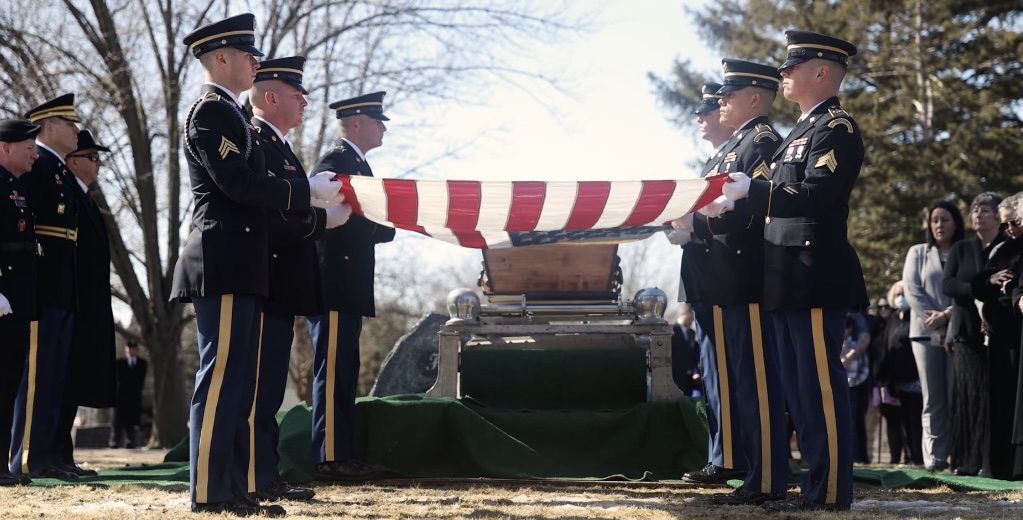President Donald Trump marked Memorial Day on May 26 with an all-caps rant about “scum” who allegedly “spent the last four years trying to destroy our country,” and “USA hating judges” he characterized as “monsters who want our country to go to hell.” It’s becoming a regular thing for Trump to use this day as another excuse to settle scores with political opponents.
Most people in public life understand that the holiday originally known as Decoration Day is intended to honor Americans who died during military service.
The Iowa National Guard posted a video on May 26 to illustrate the training that goes into offering military funeral honors at approximately 1,400 services in Iowa each year. Sgt. Lorenzo Lopez of the Iowa Army National Guard’s Military Funeral Honors team explained the various roles and steps, and how team members focus on being “precise” with their movements.
Those funeral honors are available to many veterans—not just those killed during wartime service.
Today, Bleeding Heartland remembers the men and women from Iowa who lost their lives in military conflicts, from before statehood to the current decade.
Two Iowans, Captain Edwin Guthrie of Fort Madison and Major Frederick Mills of Burlington, were killed in Mexico City during the Mexican War of the 1840s.
More than 76,000 Iowans fought in the Civil War, and 13,169 died (more from disease than from combat), making it the deadliest war for Iowans. Daniel G. Clark has written about the “First Regiment of Iowa African Infantry,” organized in 1863 and later called the 60th U.S. Colored Troops, with 1,153 men (hundreds had recently come to Iowa from Missouri). Twelve from that regiment were killed during the war, and another 332 died of disease. The civil rights leader Alexander Clark had lobbied for letting Black Iowans volunteer for military service and after the war urged the legislature to extend voting rights to them.
One Iowan was killed in action during the Spanish-American War, Iowa National Guard records show. Another went missing from a scouting party, and 163 perished in “non-battle losses,” mostly from typhoid fever.
The IAgenweb site recounts that more than 500,000 Iowans registered for the draft during the Great War, more commonly known as World War I.
Iowa sent 114,242 men and women to serve during this war. One of the first U.S. soldiers killed in combat in World War I was an Iowan, Merle Hay, from Glidden. The first U.S. woman to die of injuries in a combat zone also was an Iowan, Marion Crandell, formerly a French teacher at St. Katharine’s School in Davenport. She died while serving in a canteen, when an artillery shell exploded nearby.
The Iowa Department of Veterans Affairs has calculated that 114,242 Iowans served and 3,576 died during World War I. You can find casualty lists here.
The U.S. was engaged in World War II for years, so it’s not surprising that global conflict claimed more Iowa lives. Of the 262,638 Iowans who served during that war, an estimated 8,398 died.
More than 85,000 Iowans served in the Korean War, of whom 508 died. The names of the fallen from Iowa are listed here in alphabetical order.
At least 115,000 Iowans served in the Vietnam War. The 867 Iowans who died in that conflict came from almost every county, according to this Legislative Services Agency map showing home towns of Iowans who died in military conflicts from 1962 to 2016.

Here’s the National Archives document listing all the Iowans who died in the Vietnam War.
Some 3,050 Iowans served in the Persian Gulf War, of whom seven died.
Another 885 Iowans served and two died in Panama or Grenada.
As for wars of the 21st century, Jody Ewing created a website to honor dozens of Iowans who lost their lives while serving in Iraq or Afghanistan. Last updated in 2016, that website does not include Corporal Daegan William-Tyeler Page of Red Oak, who was killed in an August 2021 suicide bombing at the Kabul airport.
May all of their memories be for a blessing.
Top photo is by Aaron of L.A. Photography, available via Shutterstock.

